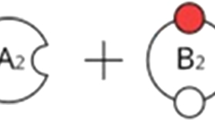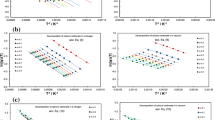Abstract
The paper concerns the most probable physical–chemical reasons of observing the kinetic compensation effects which arise at the experimental kinetic studies of complex stepwise reactions in both homogeneous systems and homological set of solid or heterogeneous systems. It is shown that, in the former case, the reason for such effects is the existence of an ‘isokinetic’ temperature when the change of the rate determining step does occur. In the latter case, the reason of the effects reflects “polychromatic” nature of kinetics of chemical transformations in heterogeneous systems as well as a peculiarity of arranging the experimental kinetic studies of such “polychromatic” processes.



Similar content being viewed by others
References
Constable FH (1923) The mechanism of catalytic decomposition. Proc R Soc Lond Ser A 108:355–378
Palmer WG, Constable FH (1924) The catalytic action of copper. Part IV. The periodic variation of the activity with temperature of reduction. Proc R Soc Lond Ser A 106:250–268
Cremer E, Marschall E (1951) Heterogener Zerfall von N2O an Katalysatoren mit variabler Aktivität. Monatsh Chem 82:840–846
Cremer E (1955) The compensation effect in heterogeneous catalysis. Adv Catal 7:75–91
Galwey AK (1977) Compensation effect in heterogeneous catalysis. Adv Catal 26:247–322
Conner WC Jr, Schwarz JA (1987) A consistent theoretical framework for analysis of diverse rate processes. Chem Eng Commun 55:129–138
Bond GC, Keane MA, Kral H, Lercher JA (2000) Compensation phenomena in heterogeneous catalysis: general principles and a possible explanation. Catal Rev Sci Eng 42:323–383
Rocha Poco JG, Furlan H, Giudici R (2002) A discussion on kinetic compensation effect and anisotropy. J Phys Chem B 106:4873–4877
Krug RR (1980) Detection of the compensation effect (θ rule). Ind Eng Chem Fundam 19:50–59
Panov GI, Parfenov MV, Parmon VN (2015) The Brønsted–Evans–Polanyi correlations in oxidation catalysts. Catal Rev Sci Eng 57:436–477
van Santen RA (2009) Modelling catalytic reactivity in heterogeneous catalysis. In: van Santen RA, Sautet P (eds) Computational methods in catalysis and material science. Wiley, Oxford, pp 417–440
McBane GC (1998) Chemistry from telephone numbers: the false isokinetic relationship. J Chem Educ 75:919–922
Lente G, Fábián I, Poë AJ (2005) A common misconception about the euring equation. New J Chem 29:759–760
Yelon A, Sacher E, Linert W (2012) Comments on “The mathematical origins of the kinetic compensation effect” parts 1 and 2 by P.J. Barrie, Phys. Chem. Chem. Phys. 2012, 14, 318 and 327. Phys Chem Chem Phys 14:8232–8234
McNaught AD, Wilkinson A (1997) Compendium of chemical terminology. IUPAC recommendations, 2nd edn. Blackwell, Oxford
Parmon VN (2010) Thermodynamics of non-equilibrium processes for chemists with a particular application to catalysis. Elsevier, Amsterdam
Parmon VN (2015) Thermodynamics of non-equilibrium processes with application to chemical kinetics catalysis, material science, and biochemistry (Russian edition, in Russian). Intellekt, Dolgoprudnyi
Zamaraev KI, Khairutdinov RF, Zhdanov VP (1985) Tunnelirovanie Electrona v Khimii. Khimicheskie Reaktsii na Bolshom Rasstoyanii (Electron Tunneling in Chemistry. Chemical Reactions at Large Distances, in Russian). Novosibirsk, Nauka
Parmon VN, Khairutdinov RF, Zamaraev KI (1974) Formal kinetics of tunnel reactions of electron transfer in solids. Solid State Phys (Fizika Tverdogo Tela) 16:2572–2577 (in Russian)
Khassin AA, Jobic H, Filonenko GA et al (2013) Interaction of hydrogen with Cu-Zn mixed oxide model methanol synthesis catalyst. J Mol Catal A Chem 373:151–160
Acknowledgments
The author acknowledges the Russian Science Foundation (Grant #14-13-01155) for a stimulation and support in the preparation of materials of this paper as well as manuscript reviewers for their reasonable comments.
Author information
Authors and Affiliations
Corresponding author
Rights and permissions
About this article
Cite this article
Parmon, V.N. Kinetic compensation effects: a long term mystery and the reality. A simple kinetic consideration. Reac Kinet Mech Cat 118, 165–178 (2016). https://doi.org/10.1007/s11144-016-1005-x
Received:
Accepted:
Published:
Issue Date:
DOI: https://doi.org/10.1007/s11144-016-1005-x




